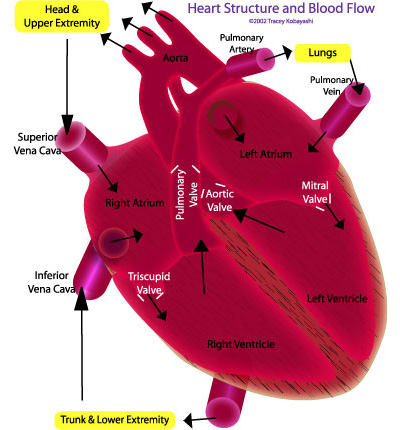
GE 345: Week 2
Circulatory System -- the Heart
Updated by Tracey 8 June 02
Intro | The Heart | Electrical Activity | Hemodynamics | Circulation |
Cardiac Cycle
Period from one end of one heart contraction to the end of the next. Initiated by generation of an action potential in the Sino-Atrial node, which travels through the atria to the atrio-ventricular bundle, then into the ventricles. Atria contract just before ventricles, pumping blood into the ventricles before ventricular contraction. Events of the cardiac cycle:
- diastole: relaxation period. Pressure gradient allows blood to flow through to ventricles.
- systole: contraction period.
- Atrial Systole: S-A Node fires an action potential, causing atria to contract
- Ventricular Systole: A-V Node fires -> ventricular contraction. A-V valve shuts when ventricular pressure higher than atrial.
The Heart

Atria receive blood from vena cava (great veins) and pulmonary veins. 70 percent flows directly into the ventricles. Atrial contraction fills the ventricles 20-30 percent more, making them primer pumps that increase ventricular effectiveness. Capable of supplying 3-400% more blood than required under resting conditions ... Atrial failure may not be noticed except during activity.
Ventricles eject blood during systole. Blood from right ventricle enters the pulmonary artery leading to the lungs. Blood from left ventricles enters aorta leading to systemic circulation.
Cardiac Output
Amount of blood pumped by the heart in a given period of time. Approx. 5000ml/min for the average adult.
C.O. = Heart Rate X Stroke Volume
HR = beats per minute
SV = End Diastolic Volume - End Systolic Volume
Example...
CO = 60 beats/min X 70 ml/beat = 4200 ml/min (7.2 l/min)
The average 70 kg (150 lb) male has a CO of 5-6 l/min
Control of CO
- Heart Rate
- SA Node rate
- Spontaneous Depolarization -- conducting cells (AV, SA, HIS, Purkinje)
- Non-Spontaneous Depolarization -- P, K, Ca gradients
-
Stroke Volume
- Starling's Law: heart pumps all blood coming in w/o allowing excessive venous pooling. Increased stretch -> increased force of contraction.
- End Systolic Volume (ESV): influenced by sympathetic activity, drugs, norepinephrine.
Intro | The Heart | Electrical Activity | Hemodynamics | Circulation |